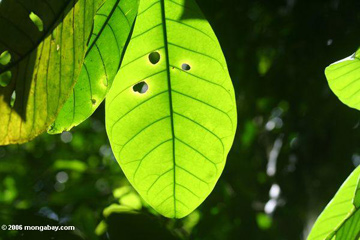Rainforest biodiversity results from habitat specialization rather than chance
mongabay.com
October 23, 2008
The rich diversity of trees in tropical forests may be “the result of subtle strategies that allow each species to occupy its own ecological niche” rather than random dispersal, report researchers writing in the journal Science.
Studying the traits of trees in Yasuni forest in Ecuador, Nathan Kraft and colleagues found evidence to support the theory that “niche separation” — subtle habitat specializations among species — drives tree diversity in the rainforest. The results are a strike against the newer “neutral theory” which attributes community composition to chance.
 |
“If the neutral theory is correct, we would expect these traits to be distributed at random throughout the forest, but that was not the case,” said Renato Valencia, professor at Pontificia Universidad Católica del Ecuador and lead investigator at the Yasuni forest plot, which is associated with the Center for Tropical Forest Science/Smithsonian Institution Global Earth Observatory network.
“The traits we measured give us important clues about the strategy of each species in the forest — how they make a living — if you will. One exciting thing that we found is that trees growing near each other tend to make a living in different ways from their neighbors,” explained Kraft. “This is a common pattern in less diverse communities, but it is hard to imagine in a hyper-diverse forest like Yasuni.”
The scientists plan to continue their research at Yasuni and other sites to better understand the patterns of biodiversity around the world. The Center for Tropical Forest Science/Smithsonian Institution Global Earth Observatory network includes more than 30 forest dynamics plots in 17 countries.
N.J.B. Kraft; D. Ackerly; R. Valencia (2008). Functional Traits and Niche-Based Tree Community Assembly in an Amazonian Forest. Science 24 October 2008